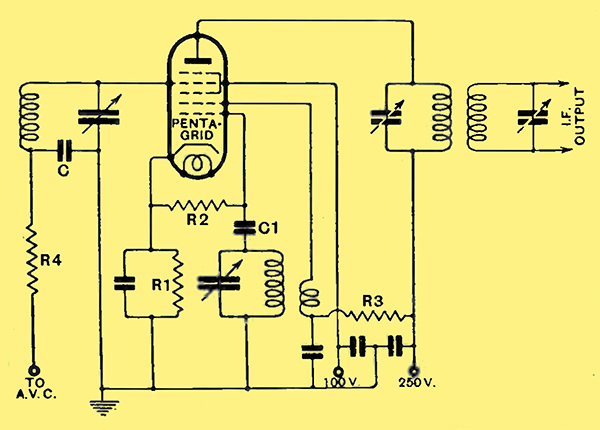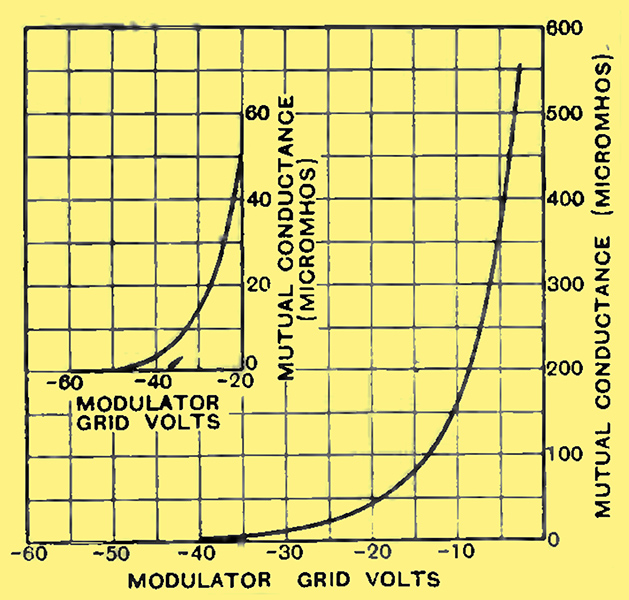|
An American development in frequency changers
Here is the first description of a new single-valve frequency changer which should simplify the construction of the superheterodyne. it combines in one envelope the electrodes necessary for triode oscillator and a variable-μ first detector with the added advantage that aerial radiation and interaction between tuning circuits is avoided.

Fig. 1. - The circuit arrangement and the electrode layout of the new Pentagrid frequency changing valve.
In view of the ever increasing popularity of the superheterodyne, the Pentagrid Converter valve which has been recently developed in America is of considerable interest. Two types of valve are available in that country: the first is intended for use in ordinary AC receivers and has a 2.5 Volts heater, while the other, which is also of the indirectly heated cathode type, is rated for 6.3 Volts for use in car sets.
The valve is intended to function as a single-valve frequency changer, and it not only oscillates and rectifies, hut complete isolation of the two processes is obtained. There are six electrodes; immediately surrounding the cathode is the oscillator grid, and outside this the oscillator anode is fitted. This does not surround the grid in the normal manner, however, but consists merely of two bars. Around the whole oscillator assembly is placed one portion of the screen-grid. Outside this is the control grid of the detector portion, then comes the second portion of the screen grid, which is connected internally to the first, and, lastly, the detector anode.
In operation the cathode, inner grid, and oscillator anode form the three electrodes of a conventional oscillator system, which is screened from the other electrodes by the first screening grid. From the point of view of connections, the cathode is common to the detector; actually, however, it is stated that the true detector cathode is a cloud of electrons existing between the first screening grid and the detector control grid. This being so, the detector cathode is a cloud of electrons, and the control grid, second screen-grid, and anode form the remaining three electrodes of an ordinary screen-grid first-detector valve, the characteristics of which are of the variable-μ type. It may thus he used for automatic volume control purposes.
Electronic Mixing
The connections for the new valve are shown in Fig. 1, from which the arrangement of the electrodes will also he apparent. It will be seen that the tuned oscillator circuit is connected between the oscillator grid and the earth line, which is negative HT for this valve, while the reaction coil in the oscillator anode circuit is coupled to it. The grid is negatively biased by means of the voltage drop set up by the passage of grid current through the resistance R2.
It will be observed that oscillation takes place among the inner electrodes of the valve, and rectification, through which the beat note between the incoming signals and the local oscillations is formed, and amplification occur in the action of the outer electrodes. Normally, where two separate valves are used, it is necessary to provide coupling between the circuits of the two valves so that the oscillations are applied to the detector as well as the signal. It is sometimes found that this coupling leads to difficulties, since with certain arrangements interaction may occur between the tuning controls, and there is a danger of radiation from the aerial unless an HF stage be used.
No such circuit coupling is employed with the Pentagrid, and the necessary coupling occurs within the valve and, by virtue of the screening, is entirely electronic in nature. It has been stated that the cathode of the variable-μ portion of the valve is a cloud of electrons around the inner screen-grid. The intensity of this cloud depends upon the instantaneous potentials of the oscillator electrodes. These are continuously changing since the valve is oscillating, and the density of the electron cloud varies in sympathy. As a result, the anode current of the variable-μ portion of the valve varies also at the oscillator frequency. The action can perhaps best be visualised by regarding the arrangement as similar to a two-valve circuit in which the first detector cathode is heated by the oscillator current so that its temperature varies with the oscillator current. With ordinary valves, of course, a scheme of this nature is impracticable on account of the temperature lag.
Good AVC Control

Fig. 2. Characteristics of the Pentagrid showing that a large negative grid bias can be applied.
Although the oscillator thus affects the operation of the detector so that electronic mixing is obtained, the potentials of the purely rectifier electrodes do not modify the oscillator action in any way. It is possible, therefore, to control volume by varying the bias applied to the control grid, so increasing the range of control in an AVC set. The curves of Fig. 2. show that the bias can be varied up to about 50 Volts negative, at which the mutual conductance is under 0.001 mA/V. This is probably impossible with any other single-valve frequency changer.
It is stated that normal type oscillator coils can be employed, and, of course, the methods of gauging the oscillator and signal frequency circuits follow the usual practice. The values of the other components depend largely upon the voltages applied to the valve, and the grid leak R2 is particularly important. If an incorrect value be employed here, a tendency to low-frequency howling or squegging may be apparent.
It will be seen, therefore, that the new valve combines within a single glass envelope the electrodes necessary for performing the functions of both a triode oscillator and a variable-μ first detector, and it is claimed that the efficiency is at least equal to the normal arrangement. Furthermore, there is the not unimportant advantage that interaction between the tuning circuits and aerial radiation is avoided. The valve, therefore, is to be welcomed as affording a simplification in the superheterodyne, and it probably represents the first efficient single-valve frequency changing device which is not open to objection on the score of difficulties due to effective balancing.
|